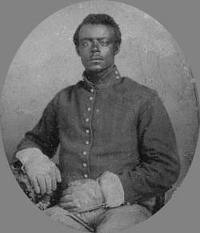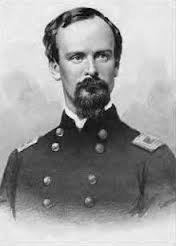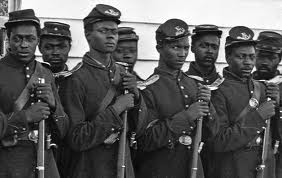 The Saltville Massacre, a Union raid in 1864, on the salt works in Virginia, would be remembered as one of the greatest racial atrocities of the Civil War and assure a Confederate Infamy. Many histories relate the battles at Fort Pillow, the Crater and others as examples of unwarranted murder, but the Saltville Massacre would combine Union Military ineptness and Confederate racial hatred, resulting in one of the darkest incidents of the Civil War. The fact that a majority of the victims bodies were never recovered, add to the mystery of the carnage, however eye-witness accounts at the trial, of one of the perpetrators, after the war, conclusively attests to the magnitude and ruthlessness of the slaughter.
The Saltville Massacre, a Union raid in 1864, on the salt works in Virginia, would be remembered as one of the greatest racial atrocities of the Civil War and assure a Confederate Infamy. Many histories relate the battles at Fort Pillow, the Crater and others as examples of unwarranted murder, but the Saltville Massacre would combine Union Military ineptness and Confederate racial hatred, resulting in one of the darkest incidents of the Civil War. The fact that a majority of the victims bodies were never recovered, add to the mystery of the carnage, however eye-witness accounts at the trial, of one of the perpetrators, after the war, conclusively attests to the magnitude and ruthlessness of the slaughter.
Stephen Gano Burbridge, born in 1831, a native of Kentucky and a Georgetown University and Kentucky Military Institute graduate, raised his own regiment during the Civil War. After officially joining the Union Army in 1864, Colonel Burbridge successfully repelled Confederate General John Hunt Morgan’s incursion into Kentucky and was given command throughout Kentucky to deal with the continuing Confederate guerrilla and partisan depredations. Known as the Butcher of Kentucky, Major General Burbridge, on President Lincoln’s orders, declared martial law, imprisoning many southern sympathizers, executing others and issued General Order 59 that stated,
“Whenever an unarmed Union citizen is murdered, four guerrillas will be selected from the prison and publicly shot to death at the most convenient place near the scene of the outrages.”
Camp Nelson, in Kentucky, was packed with newly emancipated slaves, families and 600 troopers of the 5th United States Colored Cavalry. Some reports relate as many as 10,000 residents, living in squalor, in 300 rustic cabins, on 800 acres of barren land. The 5th were issued untrained horses and Enfield, muzzle-loading, infantry rifles, unsuited for mounted engagements. Their commander, Ohio Colonel Robert W. Ratliff, was assigned to lead the untrained recruits on a strategic mission to Saltville, Virginia.
 As the Union continued to strengthen its hold on the Confederacy, ordinance and supply centers became targets of the Federal command. Saltville, Virginia and its production of salt, to preserve meat, was of tremendous importance and General Burbridge was designated to capture Saltville and crush its defenders. Ratliff’s 600 USCC and Burbridge’s 5200 troopers combined forces and began their march to Virginia in the fall of 1864. As the combined Federal forces crossed the mountains Colonel Ratliff, later related,
As the Union continued to strengthen its hold on the Confederacy, ordinance and supply centers became targets of the Federal command. Saltville, Virginia and its production of salt, to preserve meat, was of tremendous importance and General Burbridge was designated to capture Saltville and crush its defenders. Ratliff’s 600 USCC and Burbridge’s 5200 troopers combined forces and began their march to Virginia in the fall of 1864. As the combined Federal forces crossed the mountains Colonel Ratliff, later related,
“The 5th USCC were made the subject of much ridicule and many insulting remarks by the white troops, and in some instances petty outrages, such as pulling off the caps of
the colored soldiers, stealing their horses etc. These insults, as well as the jeers and taunts that they would not fight, were borne by the colored solders patiently…. In no instance did I hear colored soldiers make any reply to insulting language used toward [them] by white troops.”
 As the Union forces approached Saltville, on October 2, 1864, they came under heavy fire, that delayed their progress long enough for Rebel reinforcements to join in the engagement. The Confederate entrenchments were on a steep ridgeline and the dismounted Union troopers made several attempts to reach the enemy lines, losing several hundred in each subsequent advance. The rebel troops seeing the colored soldiers for the first time, became enraged, leaping from their fortifications, charging the Federals with bayonets fixed. General Burbridge and Colonel Ratliff became unhinged and gathered any troops they could, including walking wounded and beat a hasty retreat. The aborted and catastrophic repulse at Saltville was a complete fiasco, the field of battle littered with hundreds of Union dead, dying and wounded troopers. The ensuing carnage and racial atrocities, were yet to come. Burbridge and Ratliff fled the field, leaving their wounded to the mercy of the Confederate defenders and their murderous rampage.
As the Union forces approached Saltville, on October 2, 1864, they came under heavy fire, that delayed their progress long enough for Rebel reinforcements to join in the engagement. The Confederate entrenchments were on a steep ridgeline and the dismounted Union troopers made several attempts to reach the enemy lines, losing several hundred in each subsequent advance. The rebel troops seeing the colored soldiers for the first time, became enraged, leaping from their fortifications, charging the Federals with bayonets fixed. General Burbridge and Colonel Ratliff became unhinged and gathered any troops they could, including walking wounded and beat a hasty retreat. The aborted and catastrophic repulse at Saltville was a complete fiasco, the field of battle littered with hundreds of Union dead, dying and wounded troopers. The ensuing carnage and racial atrocities, were yet to come. Burbridge and Ratliff fled the field, leaving their wounded to the mercy of the Confederate defenders and their murderous rampage.
Several Confederate soldiers related the nightmare that continued over the next 6 days,
“They were shooting every wounded Negro they could find. Hearing firing on other parts of the field, I knew the same awful work was going on all about me.”
“The continual song of the rifle sung the death knell of many a poor Negro who was unfortunate enough not to be killed yesterday.”
“A little mulatto jumped behind a sapling, and cried out that General Duke had ordered him to remain there…it was no use. In another moment the little mulatto was a corpse.”
The racial rampage continued, even in a nearby Confederate Hospital, where a Union Surgeon, who had remained to care for the wounded, said that many wounded USCC troops were hauled into the woods, never to return. These incidents were not reserved for just the USCC, several white Union Officers were special targets of the Confederate wrath, some shot or stabbed in their hospital beds.
 Witnesses of the atrocities, who feared retribution and wanted to remain anonymous, testified that a body count would be next to impossible, since many of the dead or dying were literally dumped in a nearby sink hole or thrown in the river to float down stream. Many bottomless mine shafts dot the nearby hills and surely some contained the remains of the victims of Saltville. Local lore relates that a mass grave was dug and covered by a huge hog pen, in order to erase any evidence of the deed. An estimate of the Union dead, white and black, could exceed 300, however since the command of Burbridge and Ratliff was never documented the death toll remains unverified.
Witnesses of the atrocities, who feared retribution and wanted to remain anonymous, testified that a body count would be next to impossible, since many of the dead or dying were literally dumped in a nearby sink hole or thrown in the river to float down stream. Many bottomless mine shafts dot the nearby hills and surely some contained the remains of the victims of Saltville. Local lore relates that a mass grave was dug and covered by a huge hog pen, in order to erase any evidence of the deed. An estimate of the Union dead, white and black, could exceed 300, however since the command of Burbridge and Ratliff was never documented the death toll remains unverified.
The only participant in the Saltville atrocity brought to trial, was Confederate guerilla, Champ Ferguson. Many testified to his guilt and participation in massacre, Ferguson was hung on October, 20, 1865.
The memory of the Saltville Massacre has created a Confederate Infamy and notorious legacy that will impact Southern Heritage for eternity.
Bummer


03/31/14 Bummer-
Thanks again for the ‘detail’ insight into this particular CW incident and “war crime” in SW VA.
The salt and lead mines located in the South were of critical importance to the CSA war effort as they furnished critical war materials for the troops, arsenals and foundreys; and manufacturers.
I have seen an episode on Blue Ridge Public TV on the continuous CW skirmishes and battle at Saltville, VA (1864). Two popular CW authors and academic historians (incl. James I. Robertson) from Virginia Tech narrated the episode. This incident was presented as a CW tactical and strategic objective but no insight was presented regarding the massacre of Union troops left on the field.
John Roark
Burke, VA
John,
Thanks as always for the informative data and additions to the post. Thanks for the read.
Bummer
I knew of the connection to Champ Ferguson, but the details were very interesting to read here.
Pat;
Thanks for the read. The first photo is a survivor–after some research I’ll share his story.
Bummer
I’ve never heard of this atrocity before but I have heard black troops and their officers understood they could expect no mercy if they were wounded or captured. Thanks for bringing a new Civil War incident (for me) to my attention.
Louis,
Saltville was really the undoing of Champ Ferguson, he’s buried in your neck of the woods, in Tennesee. He was a real sociopath and probably deserved hanging, personally Burbridge should have been horse-whipped for many of his egotistical, omnipotent decisions. Champ ended up as the scape-goat for many that should have been indicted.
Bummer